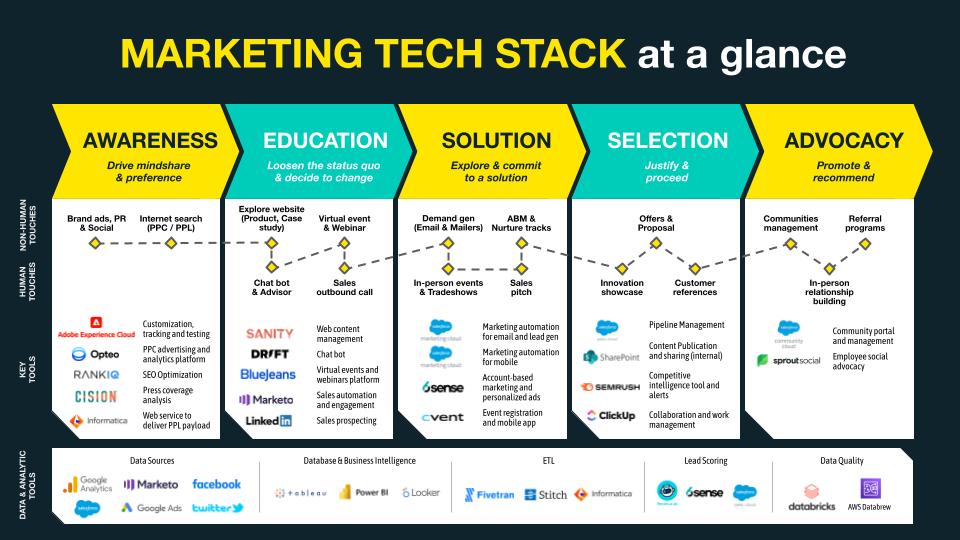How Marketing Technology Supports Your Brand

A company’s brand is only as strong as the experience it creates across the entire customer lifecycle, and today’s experiences are underpinned by technology. Customers expect brands to know who they are, what they care about and how they like to engage. Harnessing the 1:1 nature of real-world relationships at scale requires a robust and connected marketing technology infrastructure with accurate, accessible data flowing through it.
Sounds simple, right? Not quite.
We still hear pain points like this:
- “Those emails aren’t on brand!”
- “The tech stack is too complicated for the average marketer to understand.”
- “I don’t trust the data to personalize in the way I want to.”
Let’s dig a little deeper to learn why these challenges exist and what you can do about it.
The Disconnect Starts With The Way Marketing Teams Are Organized
Most marketing teams are organized into at least four core functional groups: Brand, product/portfolio marketing, performance/demand generation, and marketing operations. Grouping people together by functional expertise allows them to deepen their craft through collaboration which often results in innovation and competitive differentiation for the company. One drawback of this traditional structure is that functional silos can result in a lack of cross-functional collaboration.
The gap is especially common between brand and technology teams. The Brand team is often focused on market shaping “awareness” campaigns. Their attention is put on customer insights, creative concepts, messaging and top of funnel awareness channels. Technology teams are most connected to “lifecycle marketers” who nurture customers through their journey leveraging first party data.
As one proofpoint, we recently conducted a survey within the marketing team of a $2bn+ medtech company. 85.7% of those who work in brand marketing had a negative view of the marketing tech stack while only 20% of those in marketing operations had a negative perception of the stack. This difference in perception is stark.
I’m not suggesting that we pivot from functional teams, but rather, to underpin the org chart with processes that foster collaboration and ensure the brand people are talking to the tech people.
A Practical Example
In the summer of 2022, Peloton announced a brand refresh. According to the company’s then-CMO Dara Treseder, “Our team at Peloton Interactive has been working tirelessly behind the scenes to develop a completely NEW brand strategy, and today we’re rolling it out, complete with a new campaign…The Motivation That Moves You platform honors these experiences of our Members every day, and the motivation that they can access anytime, anywhere.”
Motivation anytime, anywhere is a brand experience that can’t live in an awareness campaign – it has to carry throughout the entire customer experience. But delivering messages that are motivating requires a deep understanding of who that customer is, where they are at in their journey and what will get them to engage.
For example, let’s take a use case as simple as “I want to send a push notification to a Peloton member who just completed a class.” That’s pretty simple. If the product team is capturing product engagement like class completions (which it does) it’s probably easy to push a message with personalized components like the member’s name, the class they took and a generic motivational message.
The message looks something like this: “Hi Jamie! Congratulations on completing your 20 minute country ride with Dennis Morton. Keep going!”
The next day, a similar text message “Hi Jamie! Congratulations on completing your 45 minute HIIT and Hills class with Tunde! Keep going!”
Getting the same message day after day isn’t motivating, and doesn’t live up to Peloton’s brand experience. Customizing the push notification with more relevant details would be far more motivating. For example, “Hi Jamie! Congratulations on completing your fourth consecutive class this week! If you liked riding with Dennis, join his class scheduled for 6 p.m. tomorrow.”
And even better, leverage the data to motivate cross-channel. This omni-channel coordination and hyper-relevance requires a lot more technology and data working in harmony to create. And hey, I get it. The juice isn’t always worth the squeeze to personalize to the micro-degree, but most brands aren’t getting basic data orchestration right because they either don’t have the right technology, data or ability to orchestrate.
Getting Started
We could write an entire book on how to orchestrate 1:1 experiences – it’s too much for one blog post. That said, I find a helpful first step is to get cross-functional collaboration on things like:
- What is our brand experience?
- How does that show up across the journey?
- What technology and data do we need to orchestrate the experience?
One way to get at these questions is to map core technology platforms to the customer journey. When you’re done, you may end up with a visual that looks something like this:

This step is just the beginning, but it creates a common framework for teams to reference when working together and also quickly identifies gaps, both in technology but also in data or process. You should revisit this journey at least once a year, if not more often.
If nothing else, I hope you’ve taken this away: Scaling a brand experience requires technology, but when brand and tech are working in silos or without collaborative processes, brand promises will fall short. Technology teams and brand teams should work together – get started today!
We’ve helped hundreds of organizations build a modern commercial technology stack that satisfies requirements across marketing, sales, customer success and product. Book a complimentary 60-minute consulting session with one of our marketing technology experts to get started.






